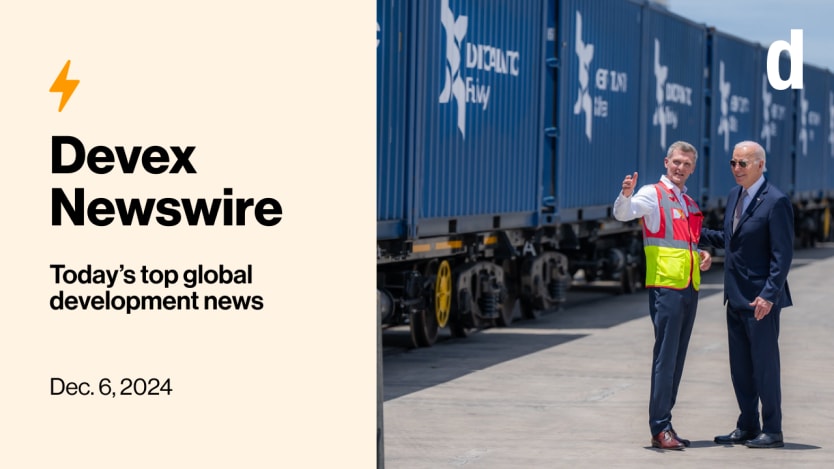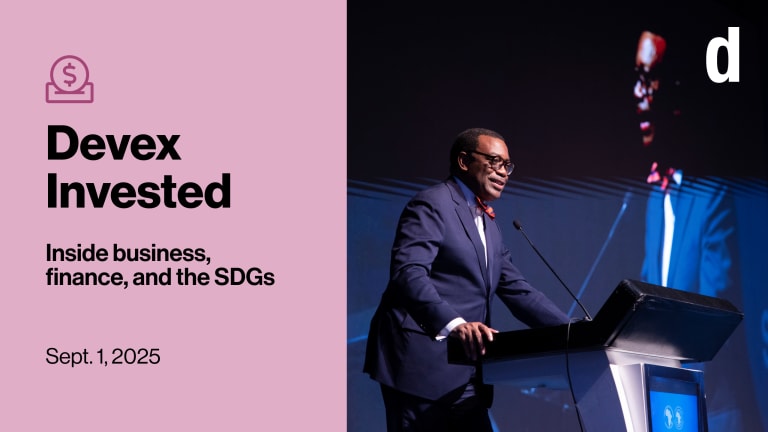Presented by International Monetary Fund

U.S. President Joe Biden is constructing a multibillion-dollar counterpunch to China’s infrastructure spree in Africa.
Also in today’s edition: The IDA replenishment numbers are in. Plus, hundreds of millions need humanitarian help, but is there a sliver of hope in the latest statistics?
This is a preview of Newswire
Sign up to this newsletter for an inside look at the biggest stories in global development, in your inbox daily.
🎧 Listen: In the latest episode of our weekly podcast series, Devex’s Raj Kumar and Adva Saldinger and Alight’s Nasra Ismail discuss how Donald Trump's cabinet picks could shape the future of U.S. global engagement.
+ Think you know the news? Test your knowledge with our quiz!
Biden builds up his Africa cred
The Lobito corridor is more than just a railroad that will connect Angola, Zambia, and the Democratic Republic of Congo. It represents the United States’ investment in Africa’s future, a dig at Chinese influence on the continent, and an outgoing president’s infrastructure swan song.
Biden’s visit this week to the Lobito Port in Angola — in the waning days of his presidency — not only fulfills a promise to visit the African continent but also underscores the strategic importance of the Lobito corridor, both to Biden’s legacy and to the U.S.-China rivalry.
“All these projects’ investments are designed to have high impact, to meet the highest standards for workers, for the environment and for the communities. Because the United States understands how we invest in Africa is just as important as how much we invest in Africa,” Biden said during his visit.
High-quality infrastructure in low-income countries — that’s the premise behind the corridor, which is the flagship project and test case of the Partnership for Global Infrastructure and Investment, a U.S.-led G7 initiative.
The Lobito project involves updating existing railway lines and building 800 kilometers of new tracks, mostly in Zambia, with the potential to extend to Tanzania. The vision is to establish a transformative economic corridor — which includes the transport of critical minerals — that will drive development and prosperity for communities along its route, my colleague Adva Saldinger writes in her in-depth report.
Alongside its ambitions, however, stand myriad questions.
What’s the long-term feasibility of the project? Can it move beyond the extractive relationships of the past? And will momentum continue under a wildly divergent Trump presidency that in the past has exhibited scant interest — and even derision — in Africa?
“It’s important but we need to be clear-eyed. If it’s going to work, it’s going to take a sustained effort and have to overcome difficulties and challenges,” Tom Sheehy of the U.S. Institute of Peace tells Adva.
But during Biden’s visit, those concerns were set aside for another day.
DRC President Felix Tshisekedi described Lobito as a “project full of hope” that’s “more than just a transportation axis. It is a unique opportunity for regional integration, economic transformation and to improve the living conditions of our fellow citizens.”
Read: The Lobito corridor — a flagship Biden project’s progress and future (Pro)
+ A Devex Pro membership helps sustain the journalism we’re able to bring you. Not yet gone Pro? Start your 15-day free trial today to access all our expert analyses, insider insights, funding data, exclusive events, the Pro Insider, and more.
Give Africa some credit
Meanwhile, in Morocco’s sunny capital of Rabat, business leaders, policymakers, and investors, including African Development Bank President Akinwumi Adesina, gathered this week to discuss an array of African investments.
Now in its sixth edition, the Africa Investment Forum has already mobilized $180 billion in investor interest over the past five years. Its mission? To connect bankable projects with commercial banks, institutional investors, and other financing sources to streamline and close deals.
Adesina opened the event by highlighting Africa’s vast investment potential, particularly in housing, infrastructure, agriculture, and digital services. A key focus of the conference so far has been the critical minerals boom and how African nations can take a bigger slice of the value created by the global energy transition, my colleague Ayenat Mersie, who is on the ground, tells me.
But alongside these opportunities, Adesina also addressed Africa’s challenges — particularly the debt burden. He noted the sharp rise in repayment obligations, which now total $74 billion compared to $17 billion in 2010. Adesina also shared a striking anecdote, recalling Kenyan President William Ruto’s remark about how a coup in Niger — thousands of miles away — translated into higher borrowing costs for Kenya.
A homegrown solution to counter bias? Adesina strongly advocated for an Africa credit rating agency.
“We at the African Development Bank and all the other partners strongly support the idea of having an Africa credit rating agency,” Adesina said in response to a question from Ayenat. “I want to be very clear — that is not a political agency. It’s going to be a world-class institution. When you and I have to go to doctors and we get a medical scan, we’ve got to be able to have a second opinion. Africa deserves to have that second opinion based on good data about the history of default rates.”
ICYMI: Risk aversion and credit ratings — why Africa is paying more for debt (Pro)
Background: Debt levels are high, but will solutions come through? (Pro)
The IDA show
The 21st replenishment of the World Bank's fund for the planet’s low-income countries — the International Development Association — has generated contributions of nearly $24 billion, the bank announced today.
“Thanks to [IDA’s] unique leveraging model, this $23.7 billion will generate a total of $100 billion in financing — the largest replenishment in IDA history,” World Bank senior managing director, Axel van Trotsenburg, told donors meeting in Seoul, South Korea.
However, commentators like Charles Kenny from the Center for Global Development were more circumspect, pointing out and expressing concern that leveraging $23.7 billion into $100 billion would reduce the quality of assistance reaching recipient countries.
“Keep the bottles corked,” Kenny urged.
Trotsenburg said that the bank's private sector arm, the International Finance Corporation, and guarantee agency, the Multilateral Investment Guarantee Agency, would provide complementary resources, “to further turbo-charge private sector development with the ultimate goal of creating jobs.”
The replenishment comes amid a major reform effort at the World Bank, something its president Ajay Banga was keen to acknowledge in an open letter this week.
“Over the years, IDA’s operational framework has grown increasingly complex, with over 1,100 different requirements and metrics. While well-intentioned, this complexity has often slowed us down and overburdened those we serve,” Banga wrote. “During this replenishment cycle, we worked closely with our partners to streamline IDA’s operations, cutting the number of required metrics in half to 500. This will make IDA simpler, faster, and more responsive to the needs of our clients. It means fewer bureaucratic hurdles and more time spent delivering results on the ground.”
ICYMI: An insider’s view of World Bank reform
Still dire, but slightly less depressing?
The prognosis is bad, but it’s a bit less bad than before — though not by much.
More than 300 million people need humanitarian support, at a potential cost of $47.4 billion, according to the Global Humanitarian Overview 2025, published Wednesday by the U.N. Office for the Coordination of Humanitarian Affairs.
But for the second year in a row, the level of need has fallen, my colleague David Ainsworth writes.
In 2023, when humanitarian need was at its worst point in recent history thanks to the onslaught of COVID-19, conflict, and climate change, the number of people in need peaked at 363 million, and the required budget stood at $56.7 billion.
Still, the latest numbers are grim.
The year 2024 was the deadliest on record for aid workers, with 281 humanitarians killed — around 63% of them in Gaza. Meanwhile, the United Nations has thus far only raised $21.2 billion out of the $49.6 billion required to fund humanitarian work in 2024.
The Norwegian Refugee Council sought to put the stats into perspective, noting that the $47.4 billion needed to help people around the world in 2025 is the same amount that Meta earned before income taxes in the fiscal year 2023.
“At a time when the richest people on earth can go to space as a tourist and trillions of US dollars are used annually on global military expenditure, it is incomprehensible that we as an international community are unable to find the necessary funding to provide displaced families with shelter and prevent children from dying of hunger,” Camilla Waszink, NRC executive director of partnership and policy, said in a statement. “There is an urgent need for a revamp of global solidarity.”
Read: Is a worldwide humanitarian crisis slowly starting to ease?
In other news
The World Bank on Thursday launched a $423 million debt-for-education swap with Côte d'Ivoire. [Reuters]
The World Health Organization has endorsed a new groundbreaking tuberculosis diagnostic tool called Xpert MTB/RIF Ultra to detect the disease with accurate results within hours. [UN News]
Italy and AfDB inked a $420 million agreement Thursday to promote and support African development. [Reuters]
Sign up to Newswire for an inside look at the biggest stories in global development.








